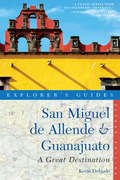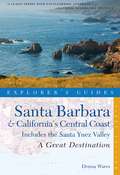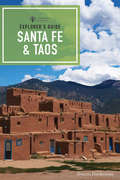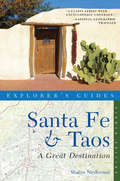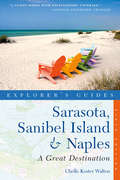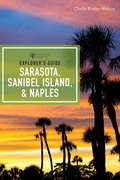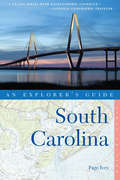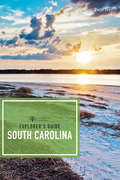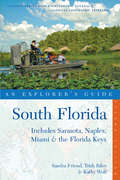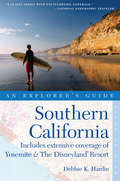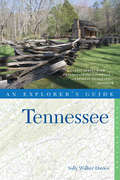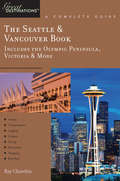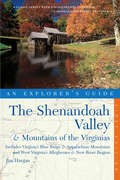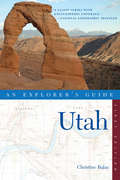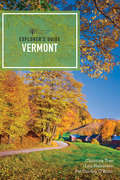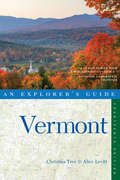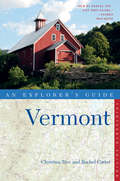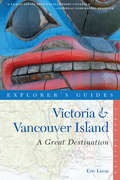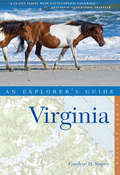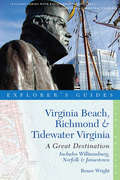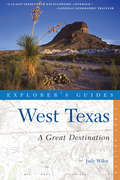- Table View
- List View
Explorer's Guide San Miguel de Allende & Guanajuato: A Great Destination (Second Edition)
by Kevin DelgadoFrom the sophisticated resorts of San Miguel de Allende to the lively festivals of Guanajuato, these celebrated colonial cities situated in the mountains north of Mexico City will allure travelers of all types. Now in its second edition, this favorite guide has been restyled and is illustrated with full-color maps and photos throughout. Distinctive for their accuracy, simplicity, and conversational tone, the diverse travel guides in our Explorer's Great Destinations series meet the conflicting demands of the modern traveler. They're packed full of up-to-date information to help plan the perfect getaway. And they're compact and light enough to come along for the ride. A tool you'll turn to before, during, and after your trip, these guides include chapters on lodging, dining, transportation, history, shopping, recreation, and more; a section packed with practical information, such as lists of banks, hospitals, post offices, laundromats, numbers for police, fire, and rescue, and other relevant information; maps of regions and locales, and more.
Explorer's Guide Santa Barbara & California's Central Coast: Includes the Santa Ynez Valley
by Donna Wares"Consistently rated the best guides to the regions covered."—National Geographic Traveler From the region’s laid-back beach towns to the jumble of Monterey’s Cannery Row, California’s Central Coast offers the most spectacular triptych of landscapes—surf, forests, and picturesque small towns—in the West. Includes coverage of the region’s vineyards, culinary gems, and coastal hideaways.
Explorer's Guide Santa Fe & Taos (9th Edition) (Explorer's Complete)
by Sharon NiedermanThe ultimate guide to New Mexico’s premier destination Now in its ninth edition, Explorer’s Guide Santa Fe & Taos is a comprehensive guide to the land of enchantment. Award-winning author Sharon Niederman provides up-to-date information on all the attractions unique to this area: traditional festivals and markets, funky cafés, lavish health spas, exciting nightlife and beautiful scenery, along with colorful details about Northern New Mexico’s fascinating and unique multicultural history. Visit the adobe-walled San Miguel Chapel, the oldest church in the U. S., or celebrate La Fiesta de Santa Fe, the oldest continuously observed festival in the country. This thoroughly updated edition features hundreds of recommendations on the best lodging, dining, sightseeing, and shopping, as well as plenty of information on the area’s rich abundance of local lore and culture. With detailed maps and more than 100 vivid photos—all packaged in the beautiful, new Explorer’s Guide layout—this is the essential companion on any voyage to this rustic corner of the Southwest.
Explorer's Guide Santa Fe & Taos: A Great Destination (Eighth Edition) (Explorer's Great Destinations)
by Sharon NiedermanHighly recommended by Travel and Leisure and New Mexico magazines, this is the ultimate guide to Santa Fe and Taos. Now in its eighth edition, Santa Fe & Taos: A Great Destination is a comprehensive guide to the land of enchantment. The author provides up-to-date information on all the attractions unique to this area: traditional festivals and markets, funky cafés, lavish health spas and beautiful scenery, along with information about Northern New Mexixo's fascinating history. This completely updated new edition has hundreds of recommendations on the best lodging, dining, sightseeing, and shopping and is now in full-color, featuring detailed maps and more than 100 vibrant photos.
Explorer's Guide Sarasota, Sanibel Island & Naples: A Great Destination (Sixth Edition) (Explorer's Great Destinations)
by Chelle Koster-WaltonGain an insider's vantage point on this exceptional part of the Florida coast.Whether Charlotte Harbor's wild shorelines and preserved estuaries, or Sarasota's historic culture sweetened by sugar magnates, travelers have an in-depth look on the environment, history, and culture of this beautiful stretch of coastline. Now in its 6th fully updated edition, this guide gives visitors and locals access to the best of Florida's Gulf Coast. Do it all, from the fabled "Sanibel stoop" for collecting seashells to dining in the finest five-star bistros. The author's deep local knowledge again provides the most reliable info available to this paradise.
Explorer's Guide Sarasota, Sanibel Island, & Naples (Seventh Edition) (Explorer's Complete)
by Chelle Koster-WaltonThe trusted guide to Florida's premier Gulf Coast destinations—now with a brand-new look! Whether Charlotte Harbor’s wild shorelines and preserved estuaries, or Sarasota’s historic culture sweetened by sugar magnates, travelers have an in-depth look on the environment, history, and culture of this beautiful stretch of coastline. Now in its 7th fully updated edition, this guide gives visitors and locals access to the best of Florida’s Gulf Coast. Do it all, from the fabled “Sanibel stoop” for collecting seashells to dining in the finest five-star bistros. The author’s deep local knowledge again provides the most reliable info available to this paradise. Each book in the Explorer’s Guide series gives travelers the tools and information they need to discover every corner of their destination. The helpful “What’s Where” section gives you the lay of the land; easy-to-read maps show you how to get around; handy icons point out amenities; and sidebars throughout recommend the must-see and must-do spots in each region. Everything you need to enjoy the beach is right here!
Explorer's Guide South Carolina (Explorer's Complete)
by Page IveyThe most up-to-date, most comprehensive guidebook to the state of South Carolina. Beaches and golf are what most people think of when they think of South Carolina, and the state has those amenities in abundance. But off the well-worn paths are battlefields from both the Revolutionary and Civil wars and significant guide- posts in African American history. South Carolina’s culture has great variety too, from classic Southern attitudes and food to the Geechee-Gullah Cultural Heritage Corridor in the Lowcountry and the Palmetto Trail and Scottish influences Upstate.
Explorer's Guide South Carolina (Second Edition) (Explorer's Complete)
by Page IveyThe most up-to-date and comprehensive guidebook to the state of South Carolina Beaches and golf are what most people think of when they think of South Carolina, and the state has those amenities in abundance. But off the well-worn paths are battlefields from both the Revolutionary and Civil wars and significant guide-posts in African American history. South Carolina’s culture has great variety too, from classic Southern attitudes and food to the Geechee-Gullah Cultural Heritage Corridor in the Lowcountry and the Palmetto Trail and Scottish influences Upstate. As with every title in the Explorer’s Guide series, you’ll get thoroughly researched recommendations, up-to-date information on hours and prices, and tips for enjoying the region to its fullest. South Carolina is a destination steeped in fascinating history and natural beauty. With Page Ivey’s advice, you can experience everything the Palmetto State has to offer.
Explorer's Guide South Dakota
by Marion L. HeadA definitive visitor’s guide to the beauty and tranquility of South Dakota, covering not only historical sites and tourist attractions, but also hiking, hunting, fishing and camping as well as other forms of outdoor exploration. The first and most comprehensive guide to South Dakota highlights the state’s natural beauty and includes coverage of its major historical sites and tourist attractions, from Mount Rushmore and Deadwood to the Black Hills. The guide is especially family-friendly, outlining free or inexpensive activities as well as little known treasures that were discovered through personal experience and research on the ground. As in all Explorer's Guides, this book includes up-to-date maps and handy icons that point out places of extra value, family- and pet-friendly establishments, those that provide wheelchair access, and even selective shopping and special events listings.
Explorer's Guide South Florida: Includes Sarasota, Naples, Miami & the Florida Keys (Second Edition)
by Sandra Friend Kathy Wolf Trish RileyThis completely revised second edition of the definitive South Florida guidebook offers coverage of Tampa, the Gulf Coast, South Beach, Miami, and the Keys. In diverse, exciting South Florida you might catch a glimpse of an endangered Florida panther in a nature preserve in the morning and visit a four-star restaurant and world-class nightclub that evening. This rich destination welcomes visitors from all over the world with its vibrant arts communities and multicultural historic sites, luxurious seaside resorts and lush forests, and some of the best fishing and diving in the United States. With cattle ranches and citrus groves all the way down to the mighty swamps of the Everglades and Big Cypress there are endless opportunities for exploration and discovery for singles, couples, and families. From eco-friendly establishments and environmental information about the region to its trendy nightlife, out-of-the-way attractions, and best beach hotels, Explorer’s Guide South Florida is a thorough introduction to an alluring place that tourists as well as locals simply shouldn’t miss. Detailed maps, an index, an alphabetical “What’s Where” subject guide, and helpful icons that highlight places that offer special value, are pet-, gay-, and family-friendly, and are wheelchair accessible round out this incredible resource, your perfect travel companion.
Explorer's Guide Southern California: Includes Extensive Coverage of Yosemite & The Disneyland Resort
by Debbie K. HardinThis Explorer's Guide focuses on the wide range of activities and vast culture of Southern California. Explore this vacation-lover’s wonderland of outdoor activities like golf, surfing, kayaking, and hiking and top-10 lists for destinations throughout the area. In addition to Los Angeles, San Diego, Santa Barbara, San Luis Obispo, and the Inland Empire, coverage includes wild spaces like Joshua Tree, Yosemite National Park, Sequoia, and King’s Canyon. With extensive coverage of Disneyland and an exhaustive list of the best beaches.
Explorer's Guide Tennessee (Explorer's Complete #0)
by Sally Walker DaviesWith Explorer’s Guides, expert authors and helpful icons make it easy to locate places of extra value, family-friendly activities, and excellent restaurants and lodgings. Regional and city maps help you get around and What’s Where provides a quick reference on everything from tourist attractions to off-the-beaten-track sites. From wild, open spaces in the Great Smokies to the rhythms that define Memphis and Nashville to charming small-town squares and character-filled city streets, all corners of Tennessee are explored in this indispensable guide. With honest opinions and engaging descriptions, Sally Walker Davies takes you into the heart and soul of her home state.
Explorer's Guide The Four Corners Region: A Great Destination
by Sara J. BensonExplorer's Great Destinations puts the guide back into guidebook. This Explorer's Great Destinations guidebook focuses on the Four Corners Region of the American Southwest, including parts of Arizona, New Mexico, Colorado, and Utah.
Explorer's Guide The Seattle & Vancouver Book: Includes The Olympic Peninsula, Victoria And More: A Complete Guide (Explorer's Great Destinations #0)
by Ray ChatelinSavor the magical harmony of contrasts—from mountains to the sea, cosmopolitan cities to the rolling hills of wine country. On the surface, Seattle and Vancouver seem so similar as to be inseparable. Dig a little deeper, and their distinctive personalities spring forth. This book revels in the differences as well as the similarities of the two cities and the regions they occupy, and it serves as an exuberant and insightful guide to discovering and enjoying their unique offerings. As in each Great Destinations series guidebook, you'll find important contact information for lodging, dining, shopping, and recreational activities, transportation details, a calendar of events, special "If Time Is Short" options, local history, a host of photos and maps, and essential information for residents. Find out why National Geographic Traveler said the Explorer's Great Destinations series is "consistently rated the best guides to the regions covered. Readable, tasteful, appealingly designed. Strong on dining, lodging, culture, and history."
Explorer's Guide The Shenandoah Valley & Mountains of the Virginias: Includes Virginia's Blue Ridge and Appalachian Mountains & West Virginia's Alleghenies & New River Region (Explorer's Great Destinations #0)
by Jim HarganA lively, comprehensive guide to the southern Appalachians, from Virginia's Blue Ridge Mountains to the Monongahela National Forest of West Virginia. With visitation levels that rival Orlando and New York City, the southern Appalachians draw a huge array of weekenders, adventurers, and long-term visitors. This book offers historical insight, outdoor adventure, and all the information most travelers need to plan and enjoy their journey. This guide also serves as an insider's handbook to the nine national parks, offering active travelers the best access points and trailheads for kayaking, biking, and hiking excursions. In addition, this comprehensive guide to the region includes opinionated listings of inns, B&Bs, hotels, and vacation cabins; hundreds of dining reviews, from barbecue to four-star cuisine; up-to-date maps; an alphabetical "What's Where" subject guide to aid in trip planning; and handy icons that point out family-friendly establishments, wheelchair access, places of special value, and lodgings that accept pets.
Explorer's Guide Tucson: A Great Destination (Explorer's Great Destinations #0)
by Kim WestermanA comprehensive guide to Tucson and surrounding areas with hundreds of lodging, dining, and recreational recommendations. Explore the friendly, laid-back, border city of Tucson with this comprehensive addition to the Great Destinations series. This place of red deserts, awe-inspiring mountains, and cactus forests is also replete with history: Tucson was originally settled by ancient Native American peoples, Spanish explorers, and Anglo frontiersmen, and their legacy is clearly evident. While the Tucson area holds special appeal for naturalists, hikers, and birdwatchers, there are countless outdoor recreation options available—everything from ballooning to trail riding on horseback—and myriad indoor options like museums and galleries, music and dance performances, too. Tucson’s world-class resorts and spas, along with its top-rated golf courses, make it one of the best relaxation destinations in the country. And there’s no better Sonoran food north of the Mexican border than here in the Old Pueblo. Tucson offers something for everyone. Detailed maps and the author’s selective recommendations make this book a must-have for travelers and residents alike.
Explorer's Guide Utah
by Christine BalazUtah: An Explorer’s Guide introduces the reader to the best of the state’s accommodations, restaurants, and attractions. Emphasizing the appeal of Utah’s natural beauty and adventure, this guidebook includes some of the nation’s best skiing, mountain biking, and hiking, as well as galleries, entertainment, and traditional tourist attractions, including Mormon points of interest. Each item was selected for quality, location, variety, uniqueness, and regional and historical significance.
Explorer's Guide Vermont (Fifteenth Edition)
by Christina Tree Pat Goudey O'Brien Lisa HalvorsenGuiding you to the best of everything in Vermont for over 30 years! Back in its fifteenth edition, Explorer’s Guide Vermont endures as the most comprehensive and up- to- date guide to this popular New England state. With it in hand, experience the many natural and cultural wonders that make Vermont such a timeless, year- round vacation destination. Although Explorer’s Guide Vermont covers the entire Green Mountain State, the authors pride themselves on their detailed coverage of the less- traveled areas, especially the Northeast Kingdom. You’ll also find in- depth descriptions of major Vermont destinations like Burlington, Brattleboro, Manchester, and Woodstock. They highlight the most interesting and rewarding places to visit, whether on back roads or in bigger cities— artists’ studios, family farms, and historic sites among them. This guide provides great recommendations for every activity—biking; hiking and swimming; skiing, snowshoeing, and snowboarding; horseback riding, fishing, and paddling— and many more, both on and off the beaten track.
Explorer's Guide Vermont (Fourteenth Edition) (Explorer's Complete)
by Christina Tree Alice LevittGuiding you to the best of everything in Vermont for over 30 years! Although Explorer's Guide Vermont covers the entire Green Mountain State, the authors pride themselves on their detailed coverage of the state's less-traveled areas, especially the Northeast Kingdom. You'll also find in-depth descriptions of major Vermont destinations like Burlington, Brattleboro, Manchester, and Woodstock. They always highlight the most interesting and rewarding places to visit, whether on back roads or in bigger cities--artists' studios, family farms, and historic sites among them. This guide provides great recommendations for every activity you're looking for--mountain and road biking; hiking and swimming; skiing, snowshoeing, and snowboarding; horseback riding, fishing, and paddling--and many more, both on and off the beaten track.
Explorer's Guide Vermont (Thirteenth Edition) (Explorer's Complete)
by Rachel Carter Christina TreeThe definitive guide to the Green Mountain State Christina Tree and new coauthor Rachel Carter have more lovingly than ever updated the Explorer's Guide to Vermont, especially since floods in August 2011 caused by Tropical Storm Irene devastated so many of the communities, businesses, iconic covered bridges, and scenic backroads in the state. As these towns and storefronts rebuild, so have Tree and Carter This 13th edition of Explorer's Guide Vermont reviews hundreds of dining and lodging options from the remote reaches of the Northeast Kingdom to quaint Manchester and bustling Burlington. The authors offer great recommendations for the most rewarding spots to visit--artists' studios, farmers' markets, historic sites, and more--and highlight the best biking, hiking, swimming, winter sports, horseback riding, fishing, and paddling. Enjoy four seasons of events and activities; whether you're a visitor or a resident, you've got to get this guide!
Explorer's Guide Victoria & Vancouver Island: A Great Destination
by Eric Lucas"Consistently rated the best guides to the regions covered...Readable, tasteful, appealingly designed. Strong on dining, lodging, and history."—National Geographic Traveler More than a million people visit Vancouver Island by air and sea each year, three quarters of them from outside Canada. Besides detailed coverage of Victoria, Eric Lucas gives wide-ranging context to the island’s culture, cuisine, and arts. There’s also a wealth of practical information to help you plan your stay in this land of natural wonders.
Explorer's Guide Virginia
by Candyce H. StapenWith Explorer’s Guides, expert authors and helpful icons make it easy to locate places of extra value, family-friendly activities, and excellent restaurants and lodgings. Regional and city maps help you get around and What’s Where provides a quick reference on everything from tourist attractions to off-the-beaten-track sites. Virginia is for lovers—lovers of history, the outdoors, sport, and fine food! Hike and kayak at Belle Isle State Park; soak up Revolutionary history in Colonial Williamsburg; sample Piedmont wines and Eastern Shore crab cakes; or visit Arlington National Cemetery. From ocean to mountains, wildlife sanctuaries to caves, Virginia’s joys are endless.
Explorer's Guide Virginia Beach, Richmond and Tidewater Virginia: A Great Destination (Explorer's Great Destinations)
by Renee WrightThe definitive, comprehensive guide to Virginia Beach, Richmond and surrounding areas, with hundreds of lodging, dining, and recreational recommendations. Explore this vital region--Virginia Beach and Richmond, the state capitol. Author Renee Wright offers extensive coverage of Colonial Williamsburg, historic James-town, and Norfolk, home to the great Atlantic Fleet. Includes special sections on Civil War battlefields, maritime history, Hampton Roads' quadricentennial, and bird-watching opportunities in the region.
Explorer's Guide Washington (Second Edition)
by Denise FainbergIconic sites like Mount St. Helens, Mount Rainier, and Grand Coulee Dam are complemented by those undiscovered places that only a longtime local can show you. From the eastern deserts to the western rainforests, Washington is home to some of the most varied and beautiful places in the country. Iconic sites like Mount St. Helens, Mount Rainier, and Grand Coulee Dam are complemented by those unknown and undiscovered places that only a longtime local like the author can show you.
Explorer's Guide West Texas: A Great Destination
by Judy WileyNowhere else has quite the allure that west Texas cities, plains, and ranchlands have; this book is your guide to it all. West Texas is where deep blue mesas at the Big Bend and the plunging, layered walls of Palo Duro Canyon inspire awe; where off-the-beaten-path towns serve fine cuisine; where you can find a Picasso original hanging in a jailhouse museum; where views go on forever and millions of stars come out at night. Nowhere else has quite the allure that these cities, plains, and ranchlands have; this book is your guide to it all. Distinctive for their accuracy, simplicity, and conversational tone, the diverse travel guides in our Explorer's Great Destinations series meet the conflicting demands of the modern traveler. They're packed full of up-to-date information to help plan the perfect getaway. And they're compact and light enough to come along for the ride. A tool you'll turn to before, during, and after your trip, these guides include chapters on lodging, dining, transportation, history, shopping, recreation, and more; a section packed with practical information, such as lists of banks, hospitals, post offices, laundromats, numbers for police, fire, and rescue, and other relevant information; maps of regions and locales, and more.
